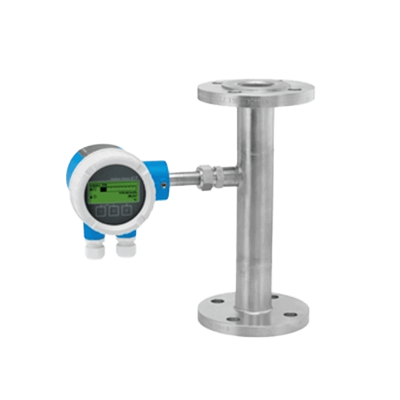What Is a Thermal Flow Meter?

A thermal flow meter is a type of flowmeter that measures the flow rate by using the thermal conduction characteristics of the fluid passing through it.
This device measures flow rate by detecting the temperature difference between the upstream and downstream of the fluid, making it particularly suitable for gas flow measurement. Although there are models for liquid flow measurement, they are typically limited to measuring small flow rates.
Thermal flow meters are sensitive to contamination, hence they are best used for measuring pure gases. They are known for their accuracy in flow rate measurement and can be applied to viscous fluids and high-temperature fluids. However, accurate measurement requires calibration and compensation due to the fluid’s thermal conductivity characteristics and temperature fluctuations. Some fluids may also exhibit slow temperature changes, affecting the response time of the meter.
Flowmeters can be categorized into two types: those measuring volume and those measuring mass. Most measure volumetric flow, but thermal flow meters are capable of measuring mass flow, which is more accurate for gases as their volume changes with temperature and pressure.
Uses of Thermal Flow Meters
Thermal flow meters are utilized in various industries for applications that require accurate gas flow measurement. Their high measurement accuracy makes them ideal for monitoring and controlling industrial processes. In chemical and semiconductor manufacturing, precise flow measurement is crucial for process stability and efficiency.
These meters are also commonly used for energy measurement, such as in heat exchangers and boilers, where they measure calorific values to monitor energy usage and enhance efficiency.
Additional applications include medical anesthesia gas flow measurement and carbon dioxide gas measurement in soft drink production and cooling systems.
Principle of Thermal Flow Meters
Thermal flow meters operate by leveraging the thermal conduction characteristics of fluids. Thermal conduction, the transfer of thermal energy through a temperature gradient, is directly proportional to the flow rate of the fluid. A faster flow rate results in quicker heat transport and a smaller temperature gradient, while a slower flow rate leads to a larger gradient.
These meters estimate the flow rate by measuring the temperature difference in the fluid, using temperature sensors placed before and after the fluid flow.
Construction of Thermal Flow Meters
A thermal flow meter typically consists of piping, a heat source, and thermometers.
1. Piping
Piping serves as the conduit for fluid flow, with the thermal flow meter mounted directly onto it. The fluid flows through the pipe, where its flow rate is measured.
2. Heat Source
The heat source, often an electric heating wire or heater, provides thermal energy to the fluid, creating a temperature difference within the piping.
3. Thermometer
Thermometers, mounted on the piping, measure the fluid’s temperature. They are strategically placed before and after the heat source to detect the temperature differences in the fluid.
Types of Thermal Flow Meters
Thermal flow meters are generally classified into two types based on their flow rate determination method: the temperature difference measurement method and the power consumption measurement method.
1. Temperature Difference Measurement Method
This method measures the temperature difference between the upstream and downstream sides of the heater. It is a cost-effective and simple configuration, often used for measuring small amounts of fluid.
2. Power Consumption Measurement Method
The power consumption measurement method maintains a constant temperature difference by adjusting the heat source’s power. The mass flow rate is calculated based on the power consumption required to keep the temperature difference constant.